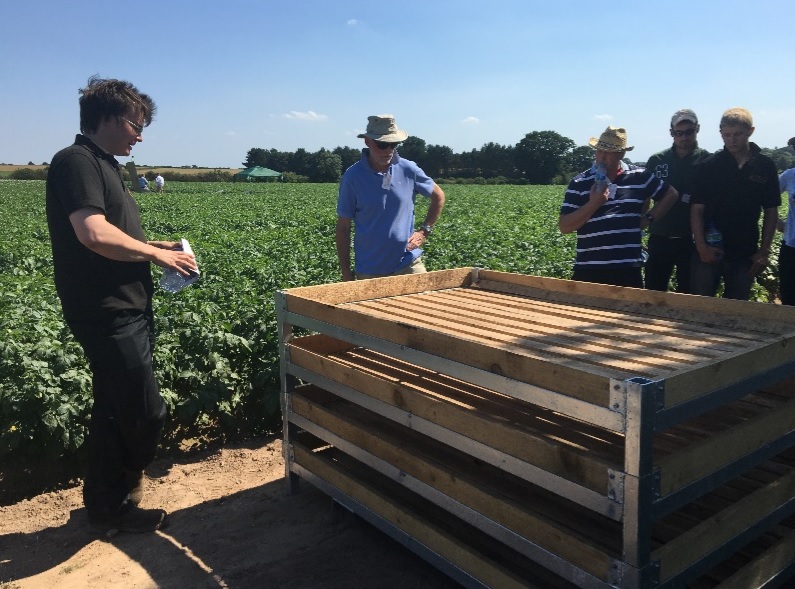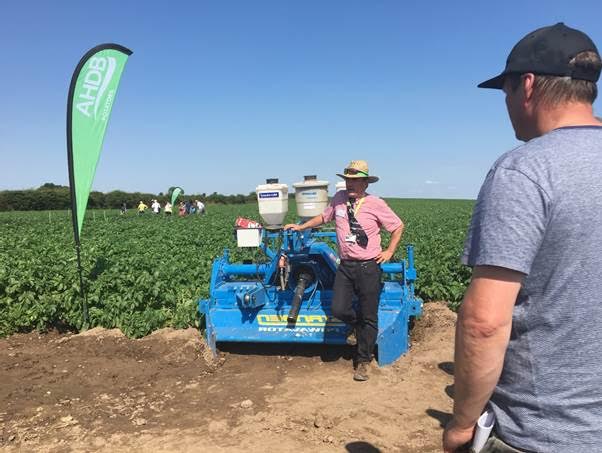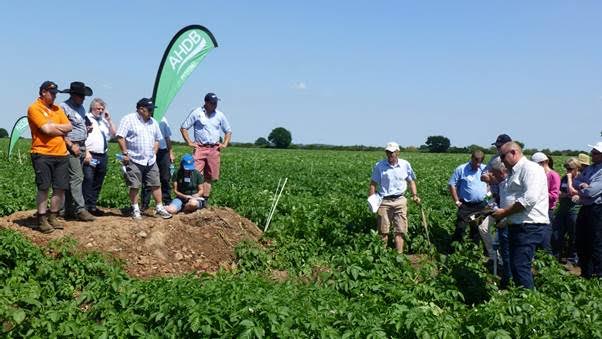
Hosts of the very first AHDB Strategic Potato (SPot) Farm opened their doors to over 100 industry peers in discussions of best practice in the face of new challenges for the second season at SPot Farm West.
W B Daw & Son, hosts of the first SPot Farm, offers growers an insight into how new systems and practice can be implemented on their own potato enterprise.
It gives levy-payers and their agronomists confidence to make changes for the benefit of their businesses and the wider supply chain.
"Last year, James Daw and his son Sam, were instrumental in getting the SPot Farm programme off the ground with 89 per cent of over 300 supply-chain visitors rating the SPot Farm as relevant to their business in its first year.
"To maintain that relevancy, James and Sam continue to innovate, sharing their findings to ensure a sustainable and prosperous future for the GB potato industry as a whole," explained Anne Stone, AHDB Potatoes Knowledge Exchange Manager and coordinator of the SPot Farm West project.

Bill Smith, who grows more than 150 hectares of potatoes, predominately for McCain Foods, travelled to the Staffordshire SPot Farm from Leominster, in Herefordshire.
"AHDB Potatoes put on an extremely practical day, with a good balance of quality speakers and a mixture of demonstrations which were very relevant to my business.
"Potato crops require a considerable investment and skill to produce. This is the first AHDB event I have attended for a long time and I’m pleased that the levy is being invested into the SPot Farm demonstrations, giving growers opportunity to explore the potential of new science alongside experts, researchers and the host farmer."

New for this year, growers were invited to review maceration and incorporation of bio-fumigant crops for PCN control, and examine plots where over-winter cover crops had been introduced to determine their added agronomic benefits.
Accounting for the effects of cover crops on nutrition
"It’s important to understand if we need to adjust nutrient calculations to account for cover crops since findings of earlier grower collaboration projects showed how rather than hitting a plateau, there is actually a downward curve effect on yield the more nitrogen you apply after a certain point," explained Marc Allison, senior researcher at NIAB CUF.
"In practical terms, this means that the doses of nitrogen some growers commonly apply as added insurance not only cost money but may also potentially cost us yield.
"Due to seasonal conditions, poor growth of the cover crop itself resulted in limited need to reduce nitrogen inputs this season, but we were surprised by a side observation where the trial plots revealed potential for cover crops to aid soil cultivability.
"Where the cover crop had been left in place and alive right up to the point of cultivating, the soil showed a 1% moisture difference at each 5cm in depth – with huge implications for ease of workability."
The benefits realised from the different methods and timing of destruction of the cover crop were highlighted by host farmer James Daw on the day.
"The observations were just jaw-dropping. We found every cultivation operation roughly 25 per cent faster where we had destroyed the cover crop on the day rather than desiccated a month earlier."
Chitting systems in modern production regimes
Modern production techniques, cost of labour and mechanical handling don’t often lend themselves to chitting.
However, in new trials this year, supported by McCain agronomist Matt Smallwood, chitted seed stocks were able to take advantage of the two good weeks at the start of the season before conditions became less suitable, advancing the plants’ canopy development and bulking.
"There’s still the rest of the season to come, and we will be following results through to harvest, yield and even storage effects, but it’s hard to see such an advantage not following through," reported Mr Smallwood.
Commenting on the personal impact, James Daw explained: "For us, it’s been a tricky few years in terms of conditions leading up to storage making it crucial to mature the maincrop quicker, bringing that harvest date earlier and allowing proper time for skin set before loading into store."
Building knowledge
Developing on findings from last year, in-field talks focused on cultivations, seed rates, and efforts to prevent tuber greening.
"A demonstration that particularly interested me was Simons Smart’s (NIAB CUF) study of tuber formation, and specifically the effects of differences in stolon architecture on tuber greening, size distribution and diseases such as common scab," added Bill Smith.
If as growers we can reduce greening and the levels we supply to our customers this will help with our contract bonus payments and improve our total marketable yield."
Working with the right kit and facilities
Final demonstrations to challenge growers’ current practices surrounded selection and optimisation of equipment and facilities.
Matt Rodenhurst, lecturer and researcher at Harper Adams University, advised on effective incorporation of nematicides: "It’s about using the right products, in the right place, at the right time, also using the right equipment.
"We want to ensure we get the nematicide around the roots of the crop rather than in the wheelings where it’s lost and not protecting the roots.
"It’s critical to maximise the concentration into the soil that will surround the rooting zone, usually 15-20cm into the destoned bed.
"Over-incorporation deep into the soil profile is comparable in reduced effectiveness to under-incorporation and lack of mixing after application."
Back at the event base, delegates learned about improvements in drip-irrigation systems used by James Daw, well suited to their water-scarce supply before being given an insider view of the reconditioned 2300 tonne potato store.
"It’s the innovation, investment and attention to detail put into this that I believe has enabled W B Daw and Son to convert this redundant cattle shed into a high-performing potato store," asserted Adrian Cunnington, Head of Sutton Bridge Crop Storage Research.
